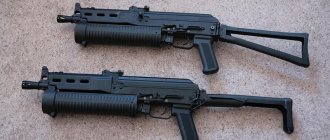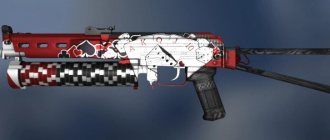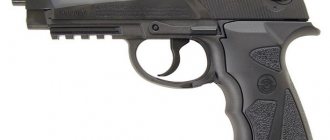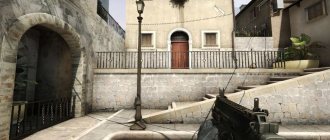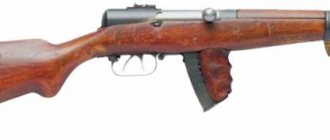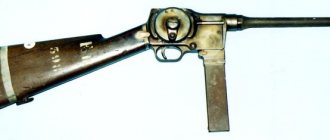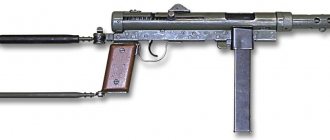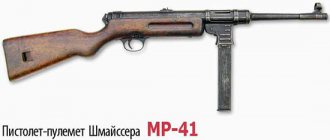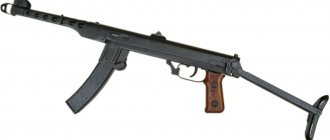Calico M960 submachine gun (USA)
Calico M960 submachine gun, 9mm caliber, with a 50-round magazine.
Calico 9mm self-loading carbine with a 100-round magazine.
Calico M950 pistol with a 50-round magazine. In front of the trigger guard, a downward-facing window for ejecting spent cartridges is clearly visible.
Calico M100 .22LR pistol (5.6mm rimfire) with 100 round magazine. Please note the differences from the 9mm models - the location of the front sight base, the round forend, the conical flash suppressor, the window for ejecting cartridges on the right side of the weapon.
Sectional drawing: Calico M950. The design of the weapon's ammunition supply system is clearly visible.
Diagram of a high-capacity magazine designed for Calico weapons.
Characteristics
Caliber:
9×19 mm Luger/Para
Weight:
2.17 kg without cartridges
Length (stock folded/unfolded):
647 / 835 mm
Barrel length:
330 mm
Rate of fire:
750 rounds per minute
Magazine capacity:
50 or 100 rounds
Submachine guns and civilian weapons (pistols and carbines chambered for pistol cartridges) of the American company Calico Light Weapon Systems, which appeared on the arms market in 1990, were distinguished by a number of original solutions. The main difference between Calico weapons was the compact cylindrical magazines of very high capacity - 50 or 100 rounds, developed by 1985 by two designers - Michael Miller and Warren Stockton. In addition, the Calico system weapon had a rather unusual layout with a magazine located above the weapon, in its rear part. The 9mm models also featured a double-sided design, with spent cartridges ejected downward. Calico submachine guns were purchased in small quantities by some US law enforcement agencies and were also sold for export, but sales of civilian self-loading models were greatly hampered by a US law passed in 1994 that limited the capacity of civilian weapon magazines to 10 rounds. As a result, Calico exited the firearms business around 2000.
Technical description. Calico submachine guns and self-loading weapons are built on the basis of automatic action with a semi-blowback, using a scheme to slow down the combat cylinder using a pair of rollers, similar to the German Heckler-Koch MP5 submachine gun. The cartridges are fed from cylindrical magazines with a capacity of 50 or 100 cartridges attached to the weapon on top. The magazines have spiral guides on their inner walls and a rotating feeder running along the axis. The feeder rotates under the action of a spiral spring located at the rear of the magazine and cocked using a special handle at the rear end of the magazine body. As the feeder rotates, the cartridges move along spiral guides forward to the outlet neck. Spent cartridges on 9mm models are ejected downwards through a special channel located in front of the trigger guard. On 5.6mm models, spent cartridges are ejected to the right, through a window in the receiver. The safety (on 9mm submachine guns it also acts as a fire mode switch) is located in the front of the trigger guard and looks like a rotary lever.
The body of the weapon is made of plastic. All 9mm models have a trapezoidal plastic forend with holes for barrel cooling, most 5.6mm (.22) models have a round forend. An additional front pistol grip can be installed under the forend of 9mm models, and the barrel can be equipped with a muzzle brake—compensator. The 5.6mm models had a characteristic flame arrester, consisting of two truncated cones with slots connected by wide bases. 9mm models with a long barrel could be equipped with a telescopic sliding butt, 5.6mm models - with removable plastic or folding down metal butts.
Sights on the 9mm models included an adjustable front sight on the front magazine release block, and a fixed, non-adjustable rear sight on the top surface of each magazine body at the rear. The 5.6mm models had a rear sight on the front magazine block and a front sight on a high triangular base in the front of the barrel, near the muzzle.
New in blogs
The Calico Light Weapon Systems company appeared in 1990 and virtually all of the company's developments were built on one single idea in the form of a high-capacity auger magazine. However, the company managed to create a huge number of weapon models, both for the army and police, and for the civilian market. Perhaps it’s worth starting with full-fledged samples, which are really submachine guns, and not their civilian versions without the ability to fire automatically. It should be noted right away that many sources indicate that the company collapsed at the beginning of 2000, but nevertheless, it’s already 2013, and the company’s website is functioning, and there are even prices for individual weapons in the catalog, so no one has gone anywhere , and the weapons are still being produced and perhaps even being developed.
Let's start with the most interesting sample, which is known as M950. This compact model of a submachine gun has a magazine with a capacity of 50 rounds, while its dimensions are comparable to the samples; the magazine is inserted into the handle of the weapon, and accordingly has a smaller capacity if its length is not up to the shooter’s knees. The M950 submachine gun does not have a stock, but this is compensated by the fact that it can be fired with one hand, which is quite convenient when firing single shots, but with automatic fire you will apparently have to grab the short forend of the weapon, since even perfect balance a submachine gun will not be able to compensate for recoil. However, for harassing fire, shooting with one hand will also work, if the shooter’s physical capabilities allow it. In addition to the auger magazine, this submachine gun has another interesting feature in the form of ejection of spent cartridges downwards, and not to the side. So many people are mistaken that a submachine gun can use both box magazines and auger magazines; I take the neck of the magazine to be the ejection point for spent cartridges. The automatic operation of the submachine gun is built on a semi-blow-back bolt, the slowing of which is provided by rollers. Thanks to this, it was possible to significantly reduce both the length of the shutter stroke and its weight. This submachine gun at one time gained great popularity, mainly due to the fact that the location of the magazine has a positive effect on the balance of the weapon, as well as the large capacity of the auger magazine, however, a more practical model, the M960, became more widespread.
At its core, this model of weapon is completely the same as the previous one, however, it has several significant changes that make it more convenient and effective and it is not at all a magazine with a capacity of 100 rounds. The main feature of this PP was the retractable stock, as well as a longer barrel and fore-end with an additional handle attached to it for holding. On the one hand, an increase in the size and weight of the weapon should have had a negative impact on the sample itself, but not a single submachine gun without a normal shoulder rest can compete in its effectiveness with the sample that has this part. Thus, thanks to an increase in the length of the barrel, the bullets received an increase in speed, and thanks to a more convenient and reliable hold of the weapon, automatic fire became more concentrated. However, the long barrel of the weapon did not last long and it was very quickly shortened, and perhaps they even did the right thing, since a muzzle brake and recoil compensator appeared on the barrel. The barrel length of the sample is 330 millimeters, while the total length of the weapon is 647 millimeters with the butt folded and 835 millimeters with the stock unfolded. Weight without cartridges is 2.17 kilograms. Magazines can be used with a capacity of either 50 or 100 rounds. The rate of fire of the sample is 750 rounds per minute.
A few words need to be said about the store, or rather, about the process of charging it. It is possible to load the magazine manually, but you must admit that pushing 100 rounds of ammunition while constantly turning the auger is still a pleasure. It was to facilitate the process of equipping the store that a folding small handle was added to its design. By placing the magazine in a device to facilitate the loading process, which is nothing more than an ordinary “funnel,” you can quickly load the magazine simply by turning this folding handle several times, and the cartridges will fall into the auger simply under its own weight. In general, a high-capacity magazine has both its pros and cons, it seems like a carload of cartridges without changing the magazine, but when you think about the equipment of this very magazine, it becomes bad.
In addition to variants of weapons chambered for 9x19 cartridges, the company has been planning since 2012 (judging by the information from their website) to create a series of samples chambered for .40 caliber cartridges, but so far everything is mute, apparently there are no people interested in such weapons.
For the civilian market and for target practice, Calico Light Weapon Systems has adapted its weapons for .22 LR cartridges. Naturally, for the civilian market such weapons are supplied only in a self-loading version, without the possibility of automatic fire.
Despite the apparent ease of adaptation, these samples are somewhat different from the versions of weapons chambered for 9x19 cartridges, and not only in that their design uses a blowback bolt. If you look closely, you will immediately notice that the cartridges in these samples are ejected through a window on the right side of the weapon, and the forend and sighting devices are slightly modified. Thus, the front sight is now mounted on a high stand on the barrel of the weapon, and the rear sight is located on a similar stand almost above the trigger. The forend of the weapon has become round and it seems that it is not connected to the receiver at all, but is only attached to the barrel. There are quite a lot of different variants of such weapons, I personally like the M100 with a magazine for 100 rounds, it’s heavy, but it doesn’t have any noticeable recoil at all, but what kind of recoil can there be for a “small” cartridge.
For the civilian market, there are quite a lot of different options for self-loading carbines based on submachine guns chambered for 9x19 cartridges. Moreover, in this case we are talking about quite suitable samples, in contrast to the recently reviewed AP 9 pistol, which can be used both for hunting and for recreational shooting, without having to think about reloading the weapon. Naturally, they are heavier than other similar models of weapons, but this is the price for a larger magazine capacity, although this is irrelevant where there is a limit on the number of cartridges in the magazine. Actually, it is precisely this restriction for civilian weapons that makes the proliferation of weapons very sluggish, since the main market for weapons is traditionally the United States, and there are restrictions there, which, although they differ by state, are largely the same. But we won’t go through all the models of civilian weapons, since there are 11 models and there is an assumption that this is not all.
In general, this is how we “gallop across Europe” about Calico submachine guns.
